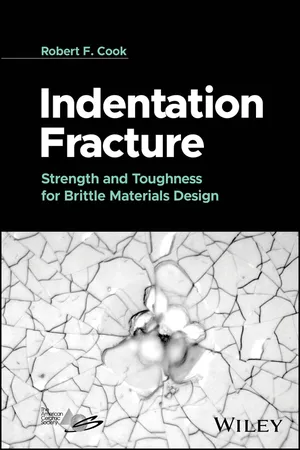
- 403 pages
- English
- PDF
- Available on iOS & Android
About this book
A comprehensive reference with demonstrations of advanced indentation fracture techniques in practical applications to enable better design and more efficient manufacturing
Indentation Fracture describes and illustrates advanced applications of indentation fracture in evaluating strength, toughness, and related properties of brittle materials. The book enables better design, manufacture, performance, and reliability of brittle materials as elements in structural components. Emphasizing the practical applications of indentation fracture techniques, especially those of indentation-strength, the book builds on a development of indentation fracture mechanics to demonstrate clear quantitative comparisons and rankings of material fracture behavior, including the behavior of toughened materials.
The book includes several case studies linking indentation fracture analyses and measurements to other phenomena including fragmentation cracking, edge chipping and dicing damage, scratching and the Mohs scale, and semiconductor grinding damage. Each case study highlights a different aspect of controlled flaw fracture measurements.
The book enables readers to increase the utilization of glasses, ceramics, semiconductors, and similar brittle materials in load-bearing applications by demonstrating experimental indentation techniques to better characterize fracture. A primary focus of the book is demonstration of controlled flaw indentation-strength measurements.
Written by an independent scientist with significant research contributions to the field, Indentation Fracture explores a range of topics including:
- Brittle fracture fundamentals, discussing equilibrium fractures on uniform and localized loading leading to the Griffith and Roesler equations
- Indentation strength variation, covering the effects of contact angle, spherical and flat punch contacts, and contacts in stressed and layered components
- Toughened materials strength observations in alumina, silicon nitride, glass ceramics, ferroelastics, and zirconia
- Strengths of silicon devices determined by wafer backgrinding, covering linear flaws in silicon, including single and multiple scratches, as well as linear, general, controlled, and grinding flaws
Indentation Fracture is an essential reference on the subject for engineers across disciplines, nanotechnologists, geophysicists, and environmental scientists, along with graduate students in materials science and related programs of study.
Frequently asked questions
- Essential is ideal for learners and professionals who enjoy exploring a wide range of subjects. Access the Essential Library with 800,000+ trusted titles and best-sellers across business, personal growth, and the humanities. Includes unlimited reading time and Standard Read Aloud voice.
- Complete: Perfect for advanced learners and researchers needing full, unrestricted access. Unlock 1.4M+ books across hundreds of subjects, including academic and specialized titles. The Complete Plan also includes advanced features like Premium Read Aloud and Research Assistant.
Please note we cannot support devices running on iOS 13 and Android 7 or earlier. Learn more about using the app.
Information
Table of contents
- Cover
- Title Page
- Copyright
- Contents
- Preface
- Abbreviations and Symbols
- Chapter 1 Brittle Fracture Fundamentals
- Chapter 2 Indentation Cracking Behavior
- Chapter 3 Indentation Strengths: Invariant Toughness Materials
- Chapter 4 Indentation Strengths: Toughened Materials
- Chapter 5 Indentation Strengths: Toughness Estimation
- Chapter 6 Indentation Strengths: Reactive Environments
- Chapter 7 Dynamic Fragmentation Patterns in Flexed Ceramic Disks
- Chapter 8 Edge Chipping at Small Scales and Strengths of Diced Components
- Chapter 9 Scratches and Lateral Cracking at Linear Sharp Contacts
- Chapter 10 Strengths of Silicon Devices Determined by Wafer Backgrinding
- Chapter 11 Strength and Toughness of Cordierite Glass‐Ceramic Composites
- Chapter 12 Crack Propagation in Toughened Materials
- Chapter 13 Summary and Future
- Index
- EULA